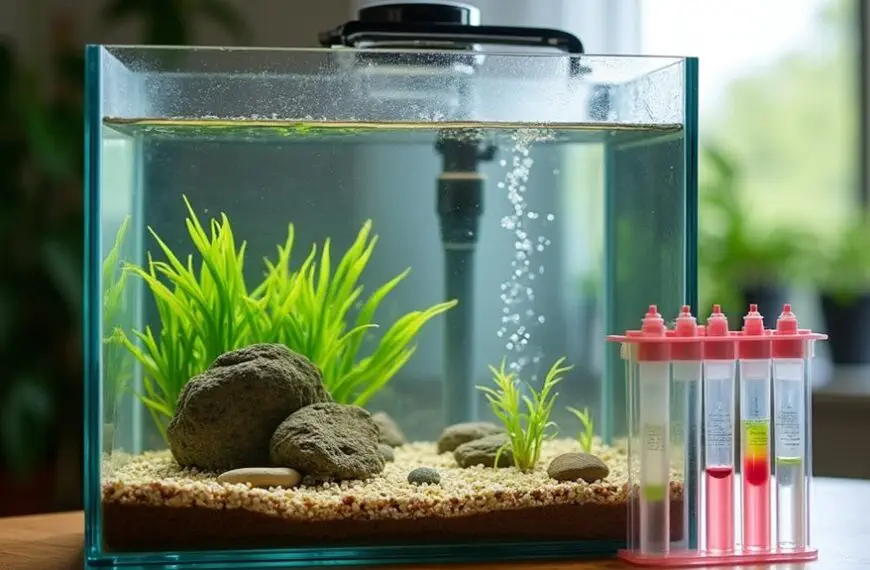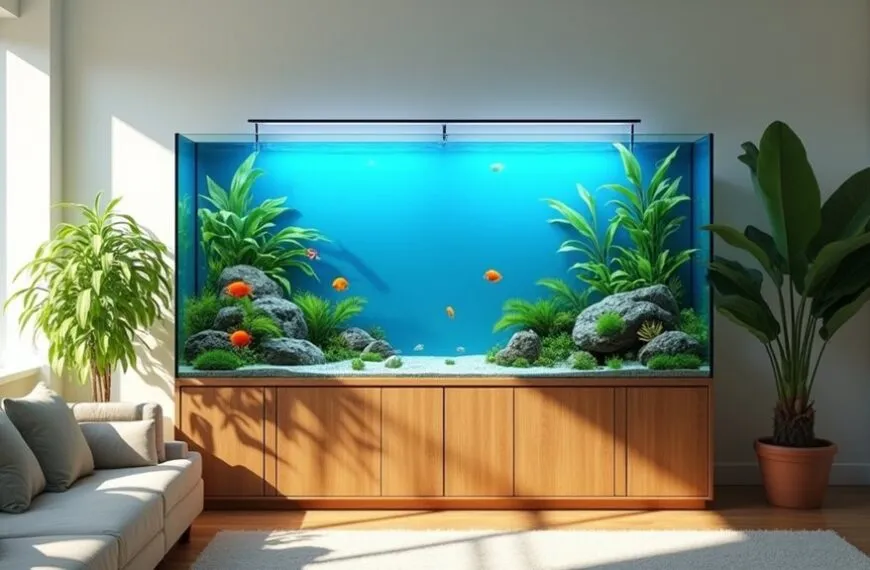Setting up a fish tank requires careful planning for your finned friends' health. Start with at least a 20-gallon tank on a sturdy surface, then add proper filtration, substrate, and a reliable heater. Install appropriate lighting and decorations to create hiding spots while maintaining swimming space. Cycle your tank for 4-6 weeks before adding fish, and establish a weekly testing routine for water parameters. Regular maintenance guarantees your underwater ecosystem thrives, preventing potential emergencies before they surface.
Contents
- 1 Choosing the Perfect Tank Size and Type
- 2 Finding the Ideal Location for Your Aquarium
- 3 Selecting Essential Equipment and Filtration
- 4 Understanding Substrate Options and Installation
- 5 Installing Proper Lighting and Temperature Controls
- 6 Adding Decorations and Creating Aquascapes
- 7 Establishing the Nitrogen Cycle
- 8 Testing and Maintaining Water Parameters
- 9 Selecting Compatible Fish Species
- 10 Implementing Regular Maintenance Routines
- 11 Frequently Asked Questions
- 12 Final Thoughts
Choosing the Perfect Tank Size and Type
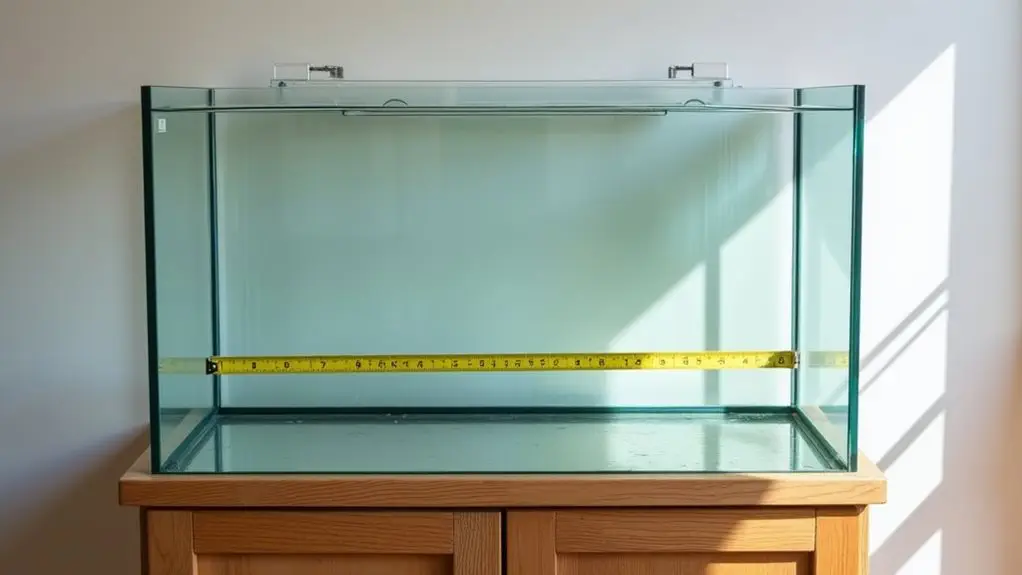
Why is selecting the right tank so essential for your underwater friends? The tank you choose becomes their entire world—their home, playground, and sanctuary all in one.
You'll want to take into account various tank shapes based on the fish species you plan to keep. Rectangular tanks typically offer more swimming space, while bowfront designs provide a unique viewing experience.
When exploring material choices, glass tanks offer clarity and scratch resistance, though they're heavier. Acrylic tanks are lighter and better insulated but may scratch more easily.
For beginners, start with at least a 20-gallon tank—it's more forgiving with water parameters and gives your fish room to thrive. Additionally, selecting an ideal tank size tailored to your chosen fish species is vital for maintaining stable water quality and preventing stress.
Finding the Ideal Location for Your Aquarium
When choosing where to place your new aquarium, you'll need to balance natural light with temperature control to keep your fish healthy and happy.
Your tank's location must have a sturdy, level surface that can support the considerable weight of water, gravel, and decorations—remember that water alone weighs about 8 pounds per gallon!
You'll also want to guarantee easy access to your tank from all sides for regular maintenance tasks like water changes, filter cleaning, and algae removal. Additionally, consider the importance of tank cycling to establish a stable aquatic environment before introducing your fish.
Light vs. Temperature Considerations
Choosing the ideal location for your aquarium involves carefully balancing light and temperature needs, which directly impact the health of your underwater community.
You'll want to find a spot that offers consistent light intensity without subjecting your tank to dramatic temperature shifts. Avoid placing your aquarium near windows where direct sunlight can cause algae blooms and dangerous temperature spikes. Trust me, your fish aren't looking for a sauna experience!
Temperature stability is essential for most aquatic species, so keep your tank away from heaters, air conditioners, and drafty areas. Additionally, ensuring that your aquarium maintains dissolved oxygen levels is vital for the overall well-being of your fish during temperature fluctuations.
Weight-Bearing Surface Needs
The most critical factor in aquarium placement is finding a sturdy, weight-bearing surface that can handle your tank's substantial heft. A standard 55-gallon aquarium weighs over 600 pounds when filled—that's like having three adult men standing in one spot!
Your floor's foundation stability is absolutely essential, as even minor settling can crack your tank and create a mini-flood in your home. Additionally, regular water changes are vital to maintaining healthy conditions, which adds more weight to the tank setup over time.
For proper load distribution, consider investing in a purpose-built aquarium stand rather than using household furniture. Bookshelves and dressers simply aren't designed for this kind of sustained weight.
Place your tank against a wall, ideally near a corner where structural support is strongest. If you're setting up on an upper floor, position it perpendicular to joists rather than parallel to distribute weight more effectively.
Accessibility for Maintenance
While structural support addresses the safety of your tank, accessibility determines how enjoyable your aquarium hobby remains long-term. You'll need to reach all areas of your tank regularly, so think carefully about placement.
Don't position your aquarium in tight corners or behind furniture where you'll struggle to perform routine tasks. Consider your maintenance schedule when choosing a location. You'll be changing water, cleaning glass, and adjusting equipment weekly or bi-weekly.
Leave at least 6-8 inches of clearance on all sides for easy tank accessibility. Remember that electrical outlets should be within reach but protected from water splashes. An ideal tank layout considers the importance of tank decoration to enhance fish happiness and reduce stress.
Nothing kills enthusiasm for the hobby faster than dreading maintenance day! A thoughtfully positioned tank makes all the difference between "quick weekend cleaning" and "frustrating afternoon wrestling with your aquarium." Your future self will thank you!
Selecting Essential Equipment and Filtration
Once you've chosen the perfect tank, it's time to focus on the gear that'll keep your aquatic friends happy and healthy. Your filter is the heart of your aquarium, so don't skimp here!
Popular filter types include hang-on-back filters (perfect for beginners), canister filters (great for larger tanks), and sponge filters (ideal for breeding tanks or fry).
When browsing equipment brands, you'll find Fluval, Marineland, and Aqueon offer reliable options for various budgets.
Don't forget other essentials: a heater to maintain stable temperatures, a thermometer to monitor it, and proper lighting for both fish health and plant growth.
Many hobbyists swear by timers to automate your lighting schedule – your fish will appreciate the consistency, and you'll enjoy the convenience! Additionally, be sure to invest in regular regular testing of water parameters to ensure a safe and healthy environment for your fish.
Understanding Substrate Options and Installation
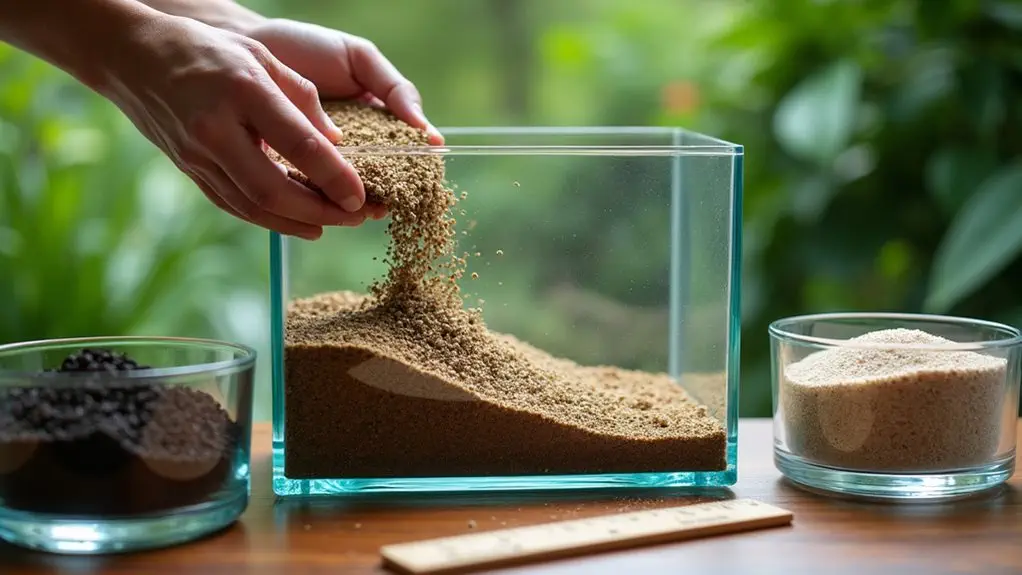
Now that you've equipped your tank with the right filtration and gear, let's talk about what goes on the bottom – substrate! This isn't just decorative; it's vital for your aquatic ecosystem.
Different substrate types serve various purposes. Gravel works well for most setups, while sand creates a natural look and is gentler on bottom-dwelling fish. Plant enthusiasts might prefer specialized nutrient-rich substrates that help roots thrive.
Getting substrate depth right is essential! For most community tanks, aim for 1-2 inches of gravel. Planted tanks need at least 2-3 inches to support root growth.
Remember, you'll need more than you think – about 1-1.5 pounds per gallon as a starting point. Additionally, the type of substrate you choose can influence water chemistry, impacting the health of your fish and plants.
Before adding substrate, rinse it thoroughly to remove dust and debris. Your fish will thank you for the clean, comfortable foundation you've created for their home!
Installing Proper Lighting and Temperature Controls
Choosing the right lighting for your fish tank illuminates your underwater world while supporting plant growth and showcasing your aquatic friends' vibrant colors.
You'll need to pair that perfect lighting with reliable temperature controls, including a quality heater and accurate thermometer, to maintain the ideal environment for your specific fish species.
Once you've installed these essential components, you'll be able to monitor and adjust both light cycles and water temperature, creating a comfortable habitat that helps your underwater community thrive. Additionally, maintaining optimal pH levels in your aquarium is crucial for the health and well-being of your fish, ensuring a stable environment for all aquatic life.
Light Types and Placement
The three essential lighting elements for your fish tank include intensity, spectrum, and duration, all of which dramatically affect your aquatic ecosystem's health.
LED lighting has revolutionized the aquarium hobby, offering energy efficiency and customizable options that your fish (and wallet) will appreciate. When selecting lights, match the lighting spectrum to your specific inhabitants—tropical fish thrive under different conditions than coldwater species.
Position your lights about 6-8 inches above the water surface to prevent overheating while ensuring proper illumination. You'll want to create a consistent light cycle of 8-10 hours daily, mimicking natural patterns. Additionally, maintaining optimal water quality is crucial as it positively affects the overall health and well-being of your fish.
Heaters and Thermometers
While proper lighting creates the perfect ambiance for your aquatic friends, maintaining the right temperature is equally important for their health and happiness. Most tropical fish thrive in water between 75-80°F, so you'll need a reliable heater to maintain consistency.
When exploring heating options, consider your tank size first. For smaller tanks (under 10 gallons), a 50-watt heater works well, while larger aquariums require more powerful units. Always place heaters near water flow areas for even heat distribution throughout the tank.
Don't skimp on thermometer accuracy! Digital thermometers provide the most precise readings, though adhesive strip thermometers work in a pinch.
Place thermometers away from heaters to get true tank temperature readings. Remember, even a few degrees off can stress your fishy pals, so check readings daily. Additionally, monitoring water quality parameters is crucial to ensure stable conditions for your fish. Your fish will thank you!
Adding Decorations and Creating Aquascapes
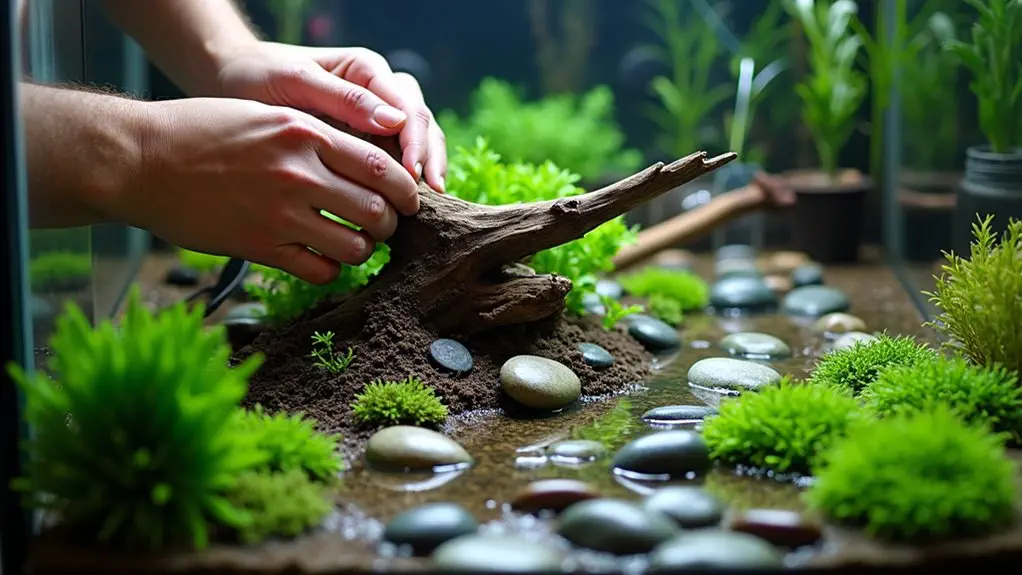
Once you've established the proper water conditions and filtration system, it's time to transform your aquarium into an underwater paradise with carefully selected decorations and thoughtful aquascaping.
Your fish aren't just swimming in water—they're living in a home that you design! With the right decorative elements and aquascaping techniques, you'll create an environment that's both beautiful and beneficial for your aquatic friends.
- Choose natural-looking decorations that won't alter water chemistry
- Create hiding spots using caves, driftwood, and plant arrangements
- Establish a focal point to draw the eye (like a unique rock formation)
- Leave open swimming spaces between decorative clusters
- Layer your design with tall plants in back and shorter ones in front
Establishing the Nitrogen Cycle
Now that your aquarium looks gorgeous with its decorative elements, it's time to focus on what happens beneath the surface. The nitrogen cycle is the invisible hero of your tank's ecosystem!
Before adding fish, you'll need to establish this essential biological process. Start by introducing ammonia sources to your tank—fish food, pure ammonia, or even hardy starter fish can do the trick.
This kickstarts the cycle, allowing beneficial bacteria to colonize your filter media and substrate. These microscopic superheroes transform toxic ammonia into nitrites, and then into safer nitrates.
Patience is key here—the cycle typically takes 4-6 weeks to complete. Test your water parameters regularly during this time.
When ammonia and nitrites read zero, and nitrates are present, you've done it! Your tank is now a safe haven for your future fish friends.
Testing and Maintaining Water Parameters
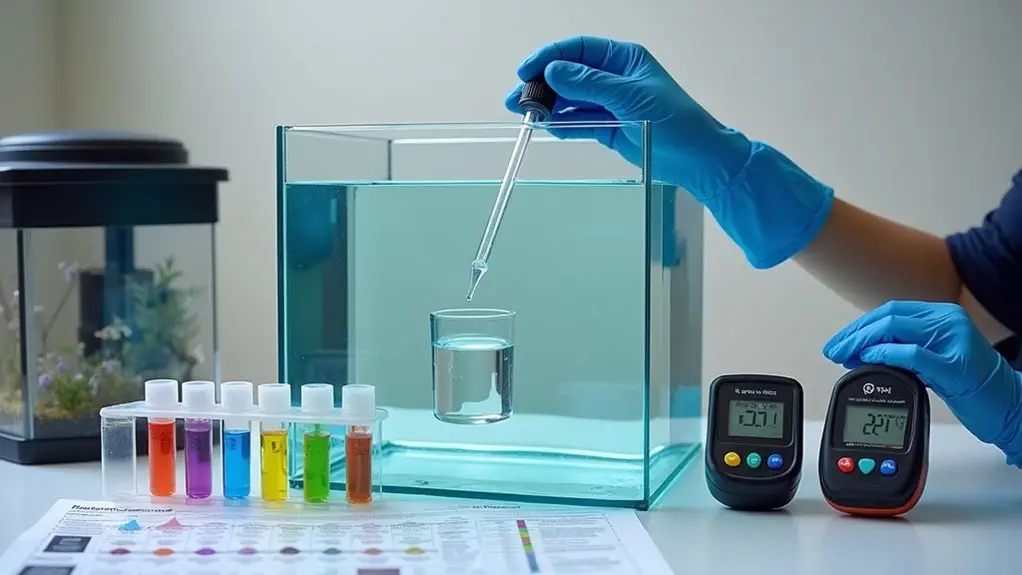
Four key water parameters will make or break your aquarium's success. pH, ammonia, nitrite, and nitrate levels aren't just numbers—they're essential signs that tell you exactly how healthy your underwater world really is.
Regular water testing helps you catch problems before your fish show signs of stress, giving you time to adjust and maintain parameter stability.
Proactive testing is your fish's first defense against invisible water quality threats.
- Test your water weekly using a reliable test kit, not just strips
- Keep a log of your readings to spot trends before they become problems
- Aim for consistency—rapid changes stress fish more than slightly imperfect parameters
- Use water conditioners that neutralize harmful chemicals in tap water
- Schedule partial water changes (15-25%) weekly to dilute nitrates and replenish minerals
Selecting Compatible Fish Species
Why do so many beginners make the costly mistake of choosing fish based solely on appearance? It's tempting to fill your tank with the most colorful specimens, but fish compatibility is essential for a thriving aquarium.
Before you bring home those eye-catching tetras or angelfish, research their species behavior carefully. Some fish are territorial bullies, while others are peaceful schoolers who'll stress without companions.
Don't mix predatory species with smaller fish—unless you want an expensive live feeding show! Consider adult size too; that adorable one-inch fish might grow to six inches and outgrow your tank.
Temperature and water chemistry preferences should align among tankmates. A good rule: if they share similar natural habitats in the wild, they'll likely coexist in your tank.
Implementing Regular Maintenance Routines

Maintaining your fish tank isn't just about feeding your aquatic friends—it's a weekly commitment to their health and happiness.
You'll need to establish a cleaning routine that includes siphoning debris, wiping algae from glass, and checking filters to keep your underwater world sparkling clean.
Regular monitoring of water parameters like ammonia, nitrite, and pH will alert you to potential problems before they affect your fish, ensuring your tank remains a thriving ecosystem.
Weekly Cleaning Essentials
The five essential weekly cleaning tasks will transform your fish tank from just surviving to truly thriving. Your finned friends deserve a clean home, and you'll love watching them zip around in crystal-clear water.
A consistent weekly routine prevents small issues from becoming big problems!
- Perform a 25-30% water change using dechlorinated water at room temperature
- Gently scrub algae from glass surfaces using a soft-bristled brush or magnetic cleaner
- Vacuum the substrate to remove trapped debris and fish waste
- Rinse filter media in old tank water (never tap water!) to preserve beneficial bacteria
- Check and adjust water parameters with a reliable test kit
Don't skip these weekly tasks—they're your best defense against common fish health problems and will keep your underwater world looking spectacular!
Monitoring Water Parameters
When your fish seem stressed or lethargic, proper water parameter monitoring becomes your first line of defense against potential disasters.
You'll need to check pH levels weekly, ensuring they remain stable for your specific fish species. Sudden pH swings can cause stress or even death in your aquatic friends.
Don't skip your ammonia testing! Even trace amounts can be toxic, so aim for zero ammonia in established tanks.
Purchase a reliable test kit with color charts that make readings simple and accurate. You'll thank yourself later when your fish thrive instead of struggling.
Set a regular schedule for water testing – Sunday mornings work great for many hobbyists.
Keep a small notebook near your tank to track readings over time. This simple habit helps you spot dangerous trends before they become emergencies.
Frequently Asked Questions
How Long Should I Wait Before Adding Fish After Setup?
You'll need to wait 4-6 weeks while the cycling process completes. Monitor your water parameters until ammonia and nitrite levels reach zero and nitrate levels are manageable. Only then should you introduce fish.
Can I Mix Saltwater and Freshwater Species in One Tank?
No, you can't mix saltwater and freshwater species in one tank. They have fundamentally different species requirements, making tank compatibility impossible. You'll kill your fish as they each need specific salinity levels to survive.
How Do I Safely Transport Fish From Store to Home?
Transport your fish using the bag method. Keep them in the store's water-filled bag, maintaining water temperature by placing it in a dark container during travel. Don't open it until you're ready for acclimation.
What Should I Do if My Fish Get Sick?
Ah, sick fish—nature's way of testing your veterinary skills! Monitor symptoms, research fish diseases, and act quickly. You'll need appropriate treatment options like medication, water changes, and quarantine tanks to nurse your finned friends back to health.
How Do I Prepare My Tank When Going on Vacation?
Before vacation, install an automatic feeder for your fish. Don't overfeed. Complete water changes and filter cleaning beforehand. Ask a trusted friend to check on tank maintenance. Consider a tank sitter for longer trips.
Final Thoughts
You're now ready to plunge into the wonderful world of fishkeeping! Remember, you'll become part-scientist, part-artist, and occasional underwater janitor. Don't worry if you make mistakes—your fish won't judge (though they might give you side-eye). With these ten steps under your belt, you've transformed an empty glass box into a thriving ecosystem. So sit back, relax, and enjoy the surprisingly addictive hobby you've just mastered!


